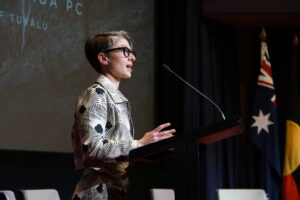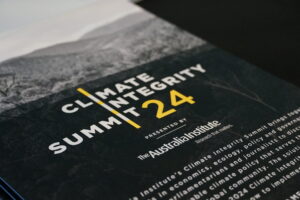The rapid rise of renewable energy technology has taken the world by surprise. Renewables have gotten cheaper faster than expected, while battery storage development is shaping up to radically change the way power our lives, from home, to work to the way we travel.
But this global phenomenon will play out locally, and in the early stages, debates about how to best deal with this transition is a major election issue in regional seats which stand to gain the most. Seats like Indi. The question will be: which communities elect members who will help them get in early and capture the huge economic opportunity of the renewables boom?
Popularity contest – won
Unlike traditional environmental issues, which can be divisive, clean energy enjoys enormous support across the board with appeal to blue, red and green voters alike. Polling conducted in Indi by The Australia Institute this year found there is high support for Australia gradually transitioning to 100% renewable energy. 85% of respondents support this policy and only 9% oppose it. This is a policy that would create jobs, boost the national economy at the same time as slashing our greenhouse gas emissions. Roughly one third of our climate pollution is caused by electricity sector emissions, so cleaning this up is a huge achievement for our country.
Significantly, there is a majority of support for switching to renewables, among all key voter groups. The lowest support, among National Party voters, is still 67%! This rises to 78% among Liberal voters and 92% of voters for the sitting MP, Cathy McGowan.
This support is a reflection of the fact that renewable energy is the winner in the energy wars. While the bad news about climate science gets the bulk of the attention, solar, wind, battery, electric vehicle and other technology has been improving at an incredible rate.
Last year was the turning point, when fossil fuels and other conventional technologies such as nuclear power were quietly overtaken by renewables for investment.
The UN Environment Program published data demonstrating that in 2015 there was more renewable energy capacity built than all other energy put together. New renewables – and this does not include large scale hydro – accounted for 53.6% of generation capacity built, worth US$286 billion.
The people of Indi are voting with their rooves. Indi now has some of the highest concentrations of solar PV ownership in the world, and these homes could be early adopters of the impending battery revolution. More than 1 in 3 dwellings already have solar PV in some Indi postcodes, according to the latest data from the Clean Energy Regulator. This does not even include solar hot water systems.
The cheapest energy: what you don’t use
The clean energy transition does not just include replacing dirty coal with clean renewables, it includes smart ways to conserve energy.
Amory Lovins, one of the world’s leading energy thinkers, called this ‘Negawatts’. He said that the most profitable energy source in the world is to use less energy. Businesses in Indi are already using energy savings to increase their profits while reducing greenhouse emissions.
In 2014 the local member, Cath McGowan hosted a forum with the federally funded ‘green bank’, the Clean Energy Finance Corporation and the Commonwealth Bank to explain how local businesses can access government backed finance to generate Negawatts and solar power.
Nu Fruit will be able to meet over 10% of its electricity needs through nearly 100 kW of rooftop solar at its Wangaratta operations, thanks to $220,000 in finance. Radevski Coolstores in Shepparton East has accessed loans for up to 100kW of solar PV and major upgrades to refrigeration, to conserve energy. Family business Nightingale Bros in Wandiligong is upgrading its refrigeration to cut its energy costs by just under 40%.
A local community group, Totally Renewable Yackandandah (TRY), is already putting these economic benefits to work, through community driven and community-owned initiatives. I was on the board of Hepburn Wind, Australia’s first community-owned wind farm, so I know how powerful these initiatives can be.
No political risk
Prime Minister Malcolm Turnbull declared that he has a plan for a new economy. He’s the self-appointed biggest fan of ‘innovation’. It is hard to see how his government can claim to have a plan for a new economy if they don’t have an ambitious plan for renewable energy.
The Labor Party has proposed a target of 50% by 2030, which would bring us up to the same level as California. The Greens have gone even further. The ball is firmly in the Coalition’s court to make a big announcement during election. There’s very little electoral harm for them to trump Labor with a more ambitious target, and with Turnbull’s communication skills and reputation for business savvy, they could easily frame their policy as an obvious way to produce ‘jobs and growth’.
Indi’s voters show that they know the renewable energy turning point has come. Any party or politician of any political stripe can turn this public support into leadership for clean energy. Indi is already ahead of the pack with high solar ownership and grassroots pushes like TRY so it’s an issue to watch.
Related documents
Between the Lines Newsletter
The biggest stories and the best analysis from the team at the Australia Institute, delivered to your inbox every fortnight.
You might also like
The Climate Crisis is an Integrity Crisis | Polly Hemming
I am starting my address to this year’s summit in the exact same way that I started last year’s address. Because it is just over a year since I delivered these same words, which aren’t actually my words. They are the words of our Climate Change Minister, and they provide a baseline of sorts for what progress has been made in that time.
Highlights from the Climate Integrity Summit 2024
2023 has shown us a planet on the brink of collapse. Cyclones, heatwaves, catastrophic floods, fires and landslides have killed people, destroyed ecosystems and decimated communities. And yet Australia is still yet to repair all the homes lost in the Black Summer bushfires of 2020 or the devastating Lismore floods of 2017 and 2022. No
Labor’s pledge to depoliticise the public service is undermined by the government only hearing what it wants to hear on climate change
While last year’s robodebt royal commission exposed a shocking lack of ethics among senior ranks of the Australian public service, the systemic condition still largely seems to be regarded as an aberration.


